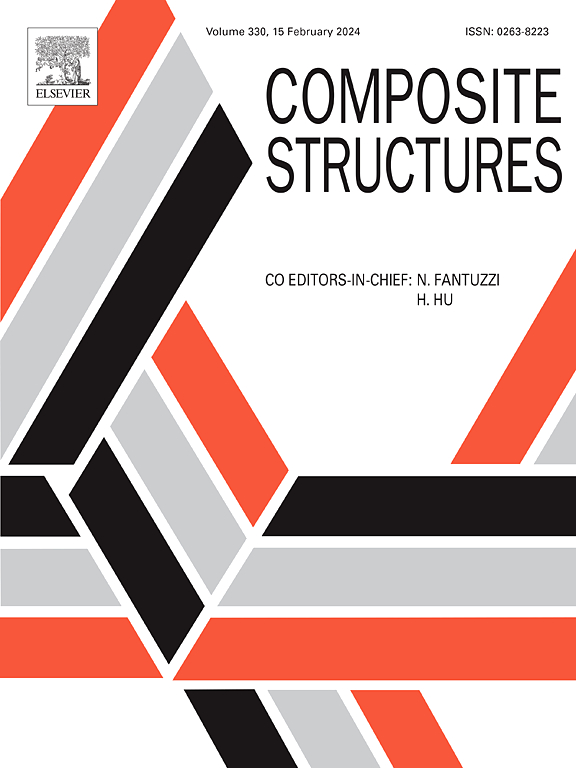新型个人防护复合材料在反复冲击下的动力行为及能量吸收试验研究
IF 6.3
2区 材料科学
Q1 MATERIALS SCIENCE, COMPOSITES
引用次数: 0
摘要
爆炸事故对人类构成严重威胁。目前的研究主要集中在工程防护材料方面,对人体防护材料的研究较少。在本研究中,将碳纤维层压板、人造软骨泡沫和金属弹簧结合在一起,开发出具有独特结构的个人防护复合材料。泡沫材料在抗冲击中起着重要作用,因此了解泡沫材料的反复冲击成为保证结构抗冲击性能和长期稳定性的关键设计参数。鉴于此,本文研究了复合材料在重复冲击下的动力行为和能量吸收机制,考虑了复合材料结构(包括线材和外径)的影响,并与传统防护材料进行了有意义的比较。结果表明,所设计的复合材料具有优异的抗冲击性能和耐久性。增加复合材料的丝径减少了变形,能量通过材料破坏消散,导致更少的冲击循环。增大复合材料外径可有效提高复合材料的比能吸收。此外,通过Split-Hopkinson压杆(SHPB)试验,发现脉冲信号的变化特征表征了复合材料在重复冲击过程中的内部破坏和损伤积累。结果表明:随着冲击损伤的累积,峰值反射应变变化率逐渐增大;研究结果为个人防护复合材料的设计和耐久性评价提供了理论依据和实验支持。本文章由计算机程序翻译,如有差异,请以英文原文为准。
Experimental investigation of dynamic behaviors and energy absorption of novel personal protective composites under repeated impacts
Explosion accident posing severe threats to human. Current research primarily focuses on engineering protective materials, with limited attention to those for human protection. In this study, personal protective composites with a unique structure were developed by incorporating carbon fiber laminates, artificial cartilage foam, and metallic springs. Considering that foamed material plays a major role in resisting impact, the knowledge of its repeated impacts becomes a key design parameter to ensure impact resistance and long-term stability of the structure. In view of this, the present work investigated the dynamic behaviors and energy absorption mechanisms of composites under repeated impacts, considering the effects of composite structure, including wire and external diameters, and providing a meaningful comparison with traditional protective materials. The results showed that designed composites demonstrated superior impact resistance and durability. Increasing the wire diameter of the composites reduced deformation, with energy being dissipated through material failure, leading to fewer impact cycles. Increasing the external diameter of the composites effectively enhanced their specific energy absorption. Moreover, the changes in the pulse signal during the Split-Hopkinson Pressure Bar (SHPB) test were found to characterize the internal destruction and damage accumulation within the composites during repeated impact. The results showed the rate of peak reflected strain change gradually increased as impact damage accumulation. These findings provide both a theoretical basis and experimental support for the design and durability evaluation of personal protective composites.
求助全文
通过发布文献求助,成功后即可免费获取论文全文。
去求助
来源期刊

Composite Structures
工程技术-材料科学:复合
CiteScore
12.00
自引率
12.70%
发文量
1246
审稿时长
78 days
期刊介绍:
The past few decades have seen outstanding advances in the use of composite materials in structural applications. There can be little doubt that, within engineering circles, composites have revolutionised traditional design concepts and made possible an unparalleled range of new and exciting possibilities as viable materials for construction. Composite Structures, an International Journal, disseminates knowledge between users, manufacturers, designers and researchers involved in structures or structural components manufactured using composite materials.
The journal publishes papers which contribute to knowledge in the use of composite materials in engineering structures. Papers deal with design, research and development studies, experimental investigations, theoretical analysis and fabrication techniques relevant to the application of composites in load-bearing components for assemblies, ranging from individual components such as plates and shells to complete composite structures.
 求助内容:
求助内容: 应助结果提醒方式:
应助结果提醒方式:


